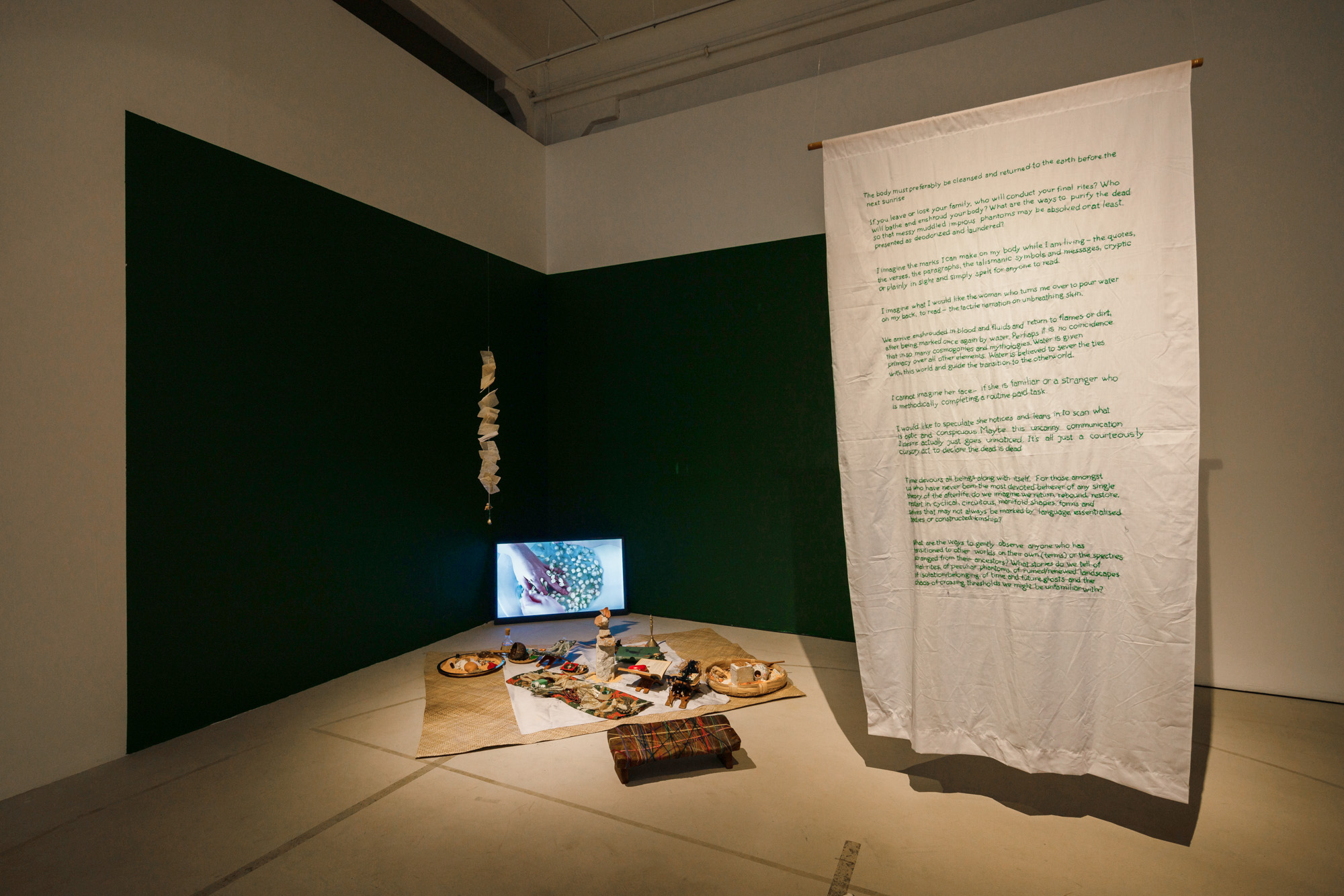Shows
“-Between- -the- Living -and- -the- Archive” at Gillman Barracks


Cultural anthropologist C. Nadia Seremetakis remarked of the role of sensory knowledge within the circuits of the everyday and the historical: “The senses are meaning-generating apparatuses that operate beyond consciousness and intention. The interpretation of and through the senses becomes a recovery of truth as collective, material experience. The senses are also implicated in historical interpretation as witnesses or record-keepers of material experience.” The pop-up exhibition “ -Between- -the- Living -and- -the- Archive,” curated by Fajrina Razak and Syaheedah Iskandar at Gillman Barracks, attempted to recuperate precisely those corporeal modes of meaning-generation that linger in the gaps between institutionalized or mainstream discourses. These are forms of knowledge that subsist in the deeply personal realm of embodied experience, in the quotidian objects and dimensions of daily existence, eluding official histories and public memory.
Several of the more compelling works were premised on otherwise unremarked oral histories and sensorial memories associated with the domestic sphere. Suriani Suratman’s Ramuan (Ingredients) (2021) consists of ceramic renditions of the lesung (mortar), once a household item in kitchens across Southeast Asia that has been supplanted by the electric blender. The artist’s use of different clays and glazes to achieve specific textural effects are likened by the artist to recipes inherited from her mother, with the final product, whether culinary or ceramic, ultimately determined by the proportion of ingredients in the mix. Similarly, the work of Hamidah Jalil—who, like her late husband, artist Mohammad Din Mohammad, is versed in traditional healing—is rooted in vernacular knowledge. The couple amassed a collection of artifacts from their travels across Southeast Asia, and on display next to her paintings of these objects is an actual piece from the collection, a secupak cup of beaten brass, adorned with symbols that the curators surmise may be derived from the Balinese astrological zodiac. Secupak, according to the wall label, translates to “one cupak,” referring both to a cylindrical container and the equivalent amount of rice or sugar connoted by the receptacle. Transposed into the aesthetic register in Suriani’s and Hamidah’s works are mundane facets of everyday life that remain occluded outside of traditional lifeworlds—a retort to the corpora of facts privileged by authorized discursive systems and the predominance of the English language and Western-derived cultural forms in Singapore’s public life.
Other exhibits channelled contemporary issues of sexual alterity and gender identity that provided acute thematic subtexts. If the realm of the sensorial and the everyday may be considered largely invisible to the broad sweep of hegemonic narratives, then the polarity between the former’s affectivity and the latter’s authority is repeated in the tension, visible in these works, between sanctioned sexualities and the growing spectrum of identities operative today—a tension that still exists in Singapore, where colonial-era laws and socio-religious norms proscribing non-normative relations and expressions remain forces to contend with. The fluid linearities and abstract forms of Aki Hassan’s Growing a Pair (2021) embraces a “nonbinary, consensual” materiality, which suggests a concern with tactility and hapticity, as well as autobiography. The artist, who uses they/them pronouns, writes: “In my process of making, I am intrigued by the way that a hard material softens (bending and stretching metal bars) and a soft material hardens (plaster powder into a plaster cast). I attempt to push a material’s limitations but only within the means that it allows me to. The outcome are objects that embody trust between myself and the material.” Zarina Muhammad’s Talismans for Peculiar Habitats (2019) is an installation of objects relating to Malay-Muslim death rites, including effigies, shrouds, and other numinous articles. Her work invokes the Islamic traditions of ghusl, the ceremonial washing of dead bodies, and kafan, their shrouding. While Talismans gestures at the artist’s abiding interest in the notion of thresholds—particularly that between the mortal and the otherworldly—it also alludes to less conspicuous aspects of her own life. In engaging with funerary rituals that are generally performed by one’s children, there is underlying reference to Zarina’s own intersecting Muslim and queer identities; the artist notes that “the work is largely about giving thanks to my queer found family who cared for me during several health crises.”

The most unanticipated and therefore noteworthy aspect of “Living Archive” was the fact that its curatorial framework was more than simply conceptual, but also reflexively informed the curators’ approach to interpersonal dialogue. Serematakis observed that the sensory and everyday “operate as spaces of social amnesia and anaesthesia,” disabled by dominant discourses, but the idea of silence and discontinuities that characterizes the themes of this exhibition likewise enabled the conversations and exchanges that went into its making. Fajrina and Syaheedah acknowledged that “Not all knowledge(s) are universal and built from a system we are accustomed to. Many of them existed outside of that system, only to be codified or extracted without mutual care. For us, holding spaces meant that it was unnecessary to pick the artwork apart and be content in that quiet space of not knowing . . . the manner of listening (and seeing) is more crucial than wanting to extract answers.” If the current pandemic has unleashed a torrent of public declarations about the need for a culture of healing and care, here were those notions put into practice—respected, embodied, lived.
“ -Between- -the- Living -and- -the- Archive” was on view at Gillman Barracks, Singapore, March 9–28, 2021.
To read more of ArtAsiaPacific’s articles, visit our Digital Library.







